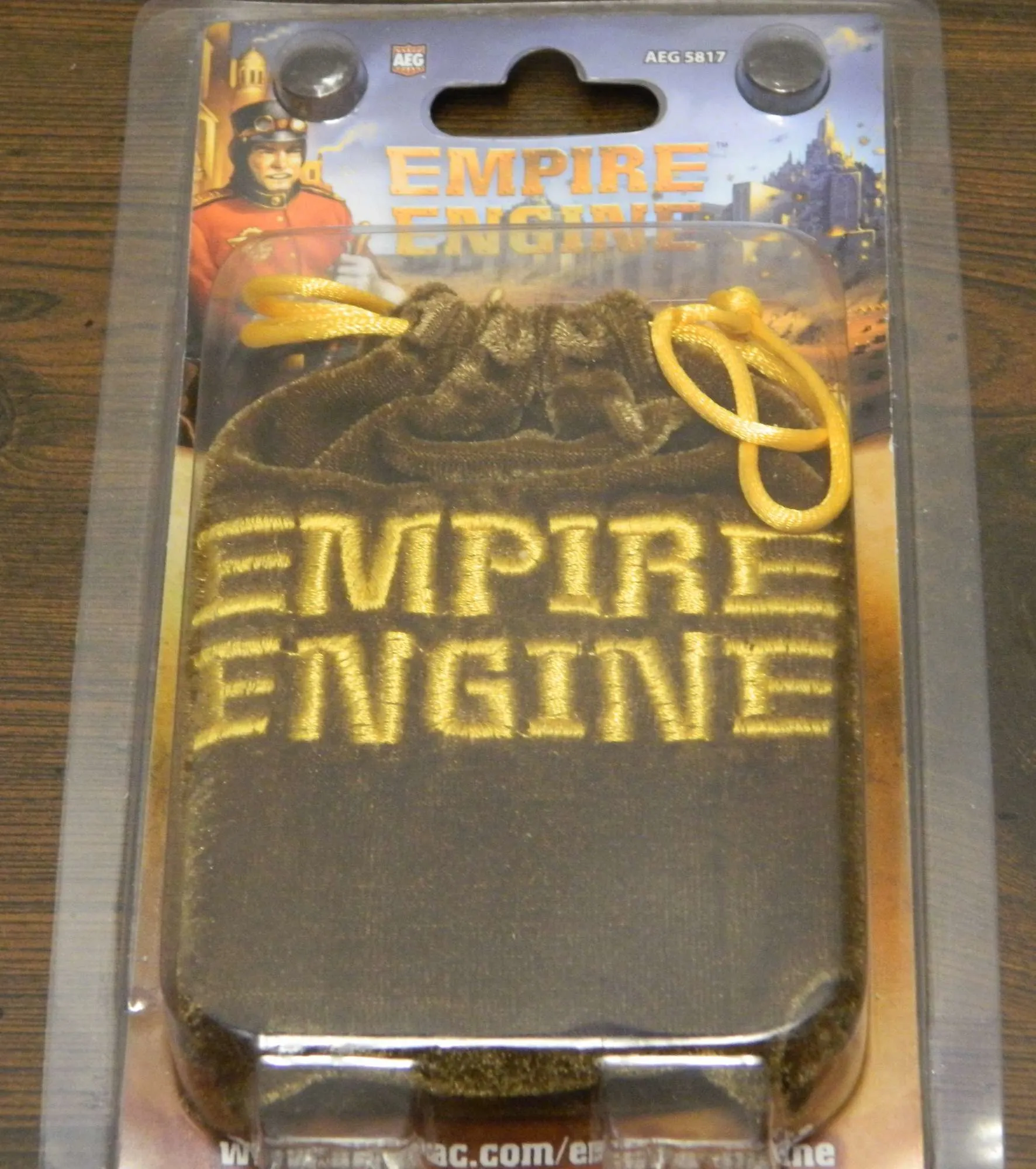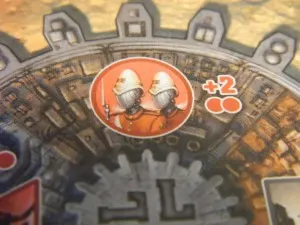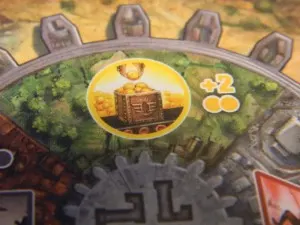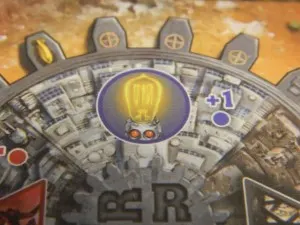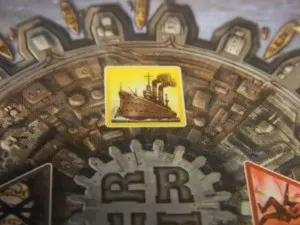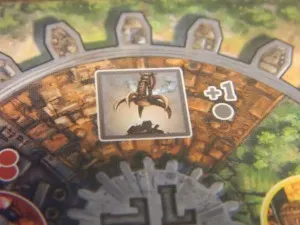How to Play
Objectives
To have the most points after the given amount of rounds.
Setup
Place all of the wooden cubes in the middle of the play area. Place the round track in the middle of the play area and place the black cube on the one space.
Each player takes two engine cards (one L and one R), two gears (1 and 2), 1 reference card, 1 soldier (red cube) and 1 good (yellow cube). Each player has two different piles of cubes with one pile being their resource pile and the other being their score pile. The soldier and good cube should be put in the resource pile. Each player should find a way to keep their score pile hidden from the other players. One player is selected at random to get the starting player card.
The game will consist of eight rounds for two and four player games while it will last nine rounds for three player games.
Controlling Your Engines
The key mechanic in Empire Engine are the two engine cards that each player possess. These two engines will determine what actions a player will take each turn. Whichever symbol is the top symbol on each card is the action that the player will be able to perform during the current turn.
During the first round each player gets to pick which action they would like to perform from each engine by placing the corresponding symbol as their top symbol. All players initially place their engines face down so everyone’s chosen actions are revealed at the same time. Players need to make sure that they place their “L” engine on their left side and their “R” engine on their right side. When everyone has made their choice, everyone reveals their engines and performs the associated actions.
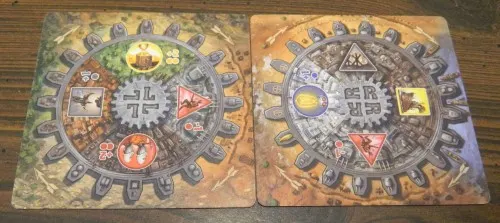
This player has decided to choose the produce and defend actions because they placed these actions as the top symbols of their engines.
After the first round players use their gear cards to control their engines. Each player has a 1 and a 2 gear. The 1 gear is used to turn the engine 90 degrees (one symbol) while the 2 gear turns the engine 180 degrees (two symbols). Starting with the first player each player places one of their gear cards face down under each of their engine cards (one for each engine). After every player has placed their first gear, starting with the last player the players play their other gear card face down under the other engine.
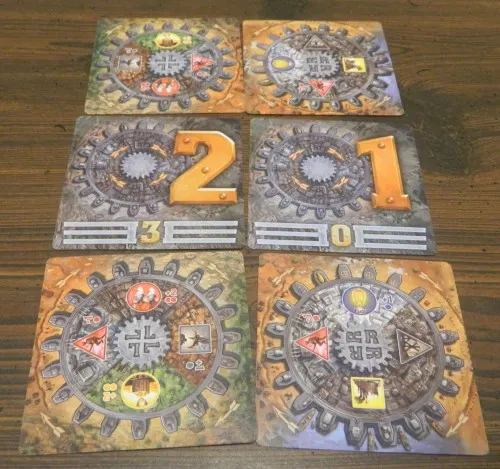
The top two engine cards show what the player’s engines looked like at the beginning of their turn. They then played the two gear on the left engine and the one gear on the right engine. The two bottom cards show how the engines would appear after being turned.
Both gear cards have two values on them. The large number on the card is the default value (1 or 2). Each card has a smaller number though which is the alternate value. The 1 card has the alternate value of 0 while the 2 card has the alternate value of 3. The zero value means that the engine will stay on the same action as the previous turn while the three means that the engine will be turned 270 degrees (three symbols). In order to use the alternate value a player must discard one of their soldier or good tokens from their resource supply.
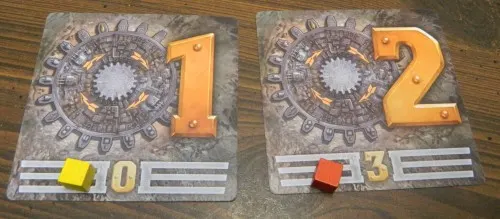
In order to use the alternate values at the bottom of the cards the player has to discard a good or soldier from their supply.
When all of the players have played their gear cards, all of the gear cards are flipped over and the engines are turned based on the gear cards played. The round then moves to the action stage.
Action Stage
Each engine card has four different symbols on it. Each symbol represents a different action that a player can perform. A player takes the actions corresponding to the top symbol of both of their engines. These actions are performed simultaneously by all of the players but the actions must be performed in the following order.
- Arm, Produce and Invent
- Attack and Defend
- Export and Salvage
Arm, Produce and Invent
Arm: Take 2 soldiers (red cubes) from the center supply and add them to your own supply.
Produce: Take 2 goods (yellow cubes) from the center supply and add them to your own supply.
Invent: Take 1 invention (blue cube) from the center supply and add it to your score pile.
If the supply in the middle of the play area is depleted of a type of resource, each player returns the same number of that colored cube to the center of the play area. Since all players will put back the same number of cubes this will not affect scoring.
Attack and Defend
Attack: In order to attack you must take one soldier cube (red) from your supply and return it to the center supply. If you don’t have a soldier cube in your supply this action is wasted since you won’t be able to perform the attack action. If the attack action is done with your left engine you attack the player on your left and if it is on the right engine you attack the player on your right. If you have the attack action active on both of your engines you will attack the player on the left and right but you must get rid of two soldier cubes.
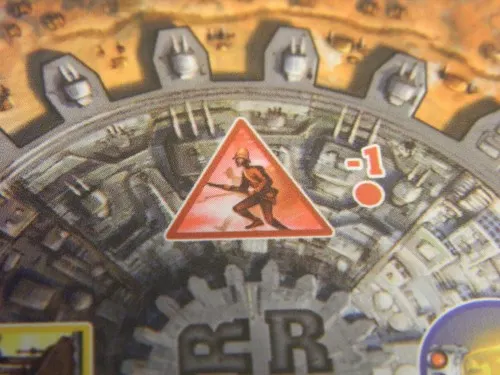
This player has chosen the attack action on their right engine. This means that they are attacking the player on their right. In order to perform the action they need to give up one of their soldier cubes.
Defend: This action blocks one attack. The defend action can either be used against an attack from your left or right. If no one attacks you, this action is wasted.
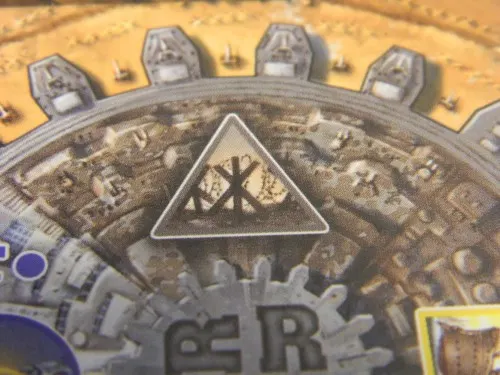
This player has chosen to defend. If the player on their left or right decided to attack them they can defend against one of their attacks.
Resolving Conflict
Attacked With No Defense: The attacking player gets to take one cube from the attacked player’s supply and put it into their score pile. If the attacked player doesn’t have any cubes in their supply the attacking player takes one soldier cube (red) from the center supply and adds it to their score pile.
Attacked With Defense: The attack is unsuccessful. The defending player takes one soldier from the center pile and adds it to their score pile. The attacking player does nothing.
Attacked By Two Players With No Defense: If a player is attacked by the player to their left and right and didn’t use the defense action, they lose one resource to both players. The first player in turn order gets to take a resource from the player’s supply first followed by the other player and put it into their score pile. If the player doesn’t have enough resources for both players, the player(s) who don’t get a resource take a soldier from the center supply and add it to their score pile.
Attacked By Two Players With Defense: The attacked player gets to decide which attack they are going to block. The attacking player who is blocked doesn’t do anything with their action. The defending player gets to take a soldier from the center supply and add it to their score pile. The other attacking player gets to take a resource from the attacked player and add it to their score pile. If the attacked player doesn’t have any resources the attacking player takes a soldier from the center supply.
Export and Salvage
If a player is attacked and they didn’t successfully defend the attack the player is unable to perform an export or salvage action. If they successfully defend against the attack or aren’t attacked at all a player can perform an export and/or salvage action.
Export: Move all of the goods cubes (yellow) from your supply to your score pile.
Salvage: Take one good (yellow), 1 soldier (red) or 1 invention (blue) from the center supply and add it to your score pile.
When all of the round’s actions have been completed, a new round begins. The starting player card is passed to the next player and the next round begins with players determining how they are going to play their gear cards.
End of Game
Once all of the rounds have been completed, the game ends. Each player scores one point for every cube in their score pile. Three bonus points are given to the player that has the most of each type of resource. If two or more players are tied for the most of a particular resource, all of the tied players get three bonus points.

Here is the scoring piles of three players. The left player has the most blue cubes and is tied for the most yellow cubes so they would receive the bonuses for blue and yellow. The middle player is tied for the most red cubes so they would receive three bonus points. The right player is tied for the most red and yellow cubes so they would receive three bonus points for both colors.
The left player has 16 points (10 cubes + 3 points yellow bonus + 3 points blue bonus). The middle player has 11 points (8 cubes + 3 points red bonus). The right player has 14 points (8 cubes + 3 points red bonus + 3 points yellow bonus). The left player would win the game.
Whoever has the most points wins the game. If two or more players are tied whoever has the most cubes in their supply breaks the tie. If players are still tied, the tied players share the victory.
Review
A recent trend in board games is the popularity of micro-games. For those of you not familiar with the term, a micro-game is a game that is generally quite small and is a quick game to pick up and play. Micro-games generally have a couple simple mechanics which makes them really easy to learn and usually take less than 20 minutes to finish. Micro-games are usually great games for when you are either traveling or don’t have a lot of time to play a game. An example of a micro-game is AEG’s Love Letter. Today I am looking at another AEG micro-game Empire Engine.
Empire Engine is the perfect example of a micro-game. The entire game fits into a small drawstring bag. The game has only one main mechanic which tells players which actions that they can perform on a given turn. The game may take five to ten minutes to learn but can be taught to a new player in a couple minutes. It takes a couple of rounds to adjust to the game but after you get familiar with the game you can probably finish a game within 15-20 minutes.
The main mechanic in Empire Engine is the engine cards. Basically Empire Engine boils down all of the actions of a traditional resource gathering game into a simple mechanic where players control two engines that they turn to choose which actions they can perform on their turn. For the most part I think the mechanic works pretty well. It takes a couple turns to fully understand what all of the different symbols mean but otherwise players can pick up the game pretty quickly.
The mechanic itself works pretty well since all of the actions are broken down into three different types of actions. You have three actions that help you gather resources to use in other actions. You have two actions that involve combat that allow you to mess with other players or defend yourself. Finally you have two actions that help you bank points. The game does a good job breaking down mechanics from a game that could take a hour or more into a game that takes 15-20 minutes.
The thing I like most about the engine mechanic is that you actually have to plan out your moves. Your decision in one round will impact your decisions in other rounds. Before making a move you need to see what moves will be available in the next round if you make the move that you are planning. Occasionally you can use the alternate moves in order to repeat actions or re position your engines but you can only do it occasionally since otherwise you will end up throwing away a bunch of cubes. Usually you are going to want to plan at least one or two turns into the future.
A side effect of the main mechanic is that each player only has a set number of options that they can perform on any given turn. This means that it is actually quite important to try and predict what actions you think your opponents are going to do in the next round. Sometimes this is actually more important than deciding what you want to do. For example if you think an opponent is going to attack you, you are going to want to defend since it will earn you a point and make your opponent waste one of their actions. Since each player has only two different gear cards players can get a good idea of what they think their opponents will do on their next turn. One of the engines has to move zero or one space while the other has to move two or three spaces. Players can use this information to get a pretty good idea what their opponents will try to do on their next turn.
While Empire Engine is a more simplified resource gathering game, there is a decent amount of strategy to the game. While luck has some impact on the game with regards to guessing what the other players are going to do, you aren’t going to win the game solely because of luck. You need to think through your strategy or you won’t win.
From what I can tell the best strategy in the game is probably to focus on one type of resource while also having a secondary resource. The third resource you should ignore for the most part. The reason I think you need one main and one secondary resource is the fact that getting the bonus three points is crucial to winning the game. If you can get two of the bonuses you are almost guaranteed to win the game. I don’t think you can win the game if you don’t win at least one of the bonuses since the players should get around the same number of cubes.
For example I ended up winning the game because I won the bonus for two of the resources by just one cube each. My strategy was to focus on those two resources while totally ignoring the other resource. By ignoring one resource I was able to focus all of my actions on getting cubes for the other two resources which made it possible to get enough cubes of two resources to get two of the bonuses. While I had pretty much the same number of total cubes as the other players, I won because I got the bonus points from two resources.
While the game does have more strategy to it than you would expect, due to the simplification the game kind of lacks mechanics. This means that the game could get dull quicker than you would expect. There is only so much you can do every game so players are likely going to end up repeating the same strategies over and over again. Empire Engine is not the type of game that I would play for long stretches of time but would occasionally come back to.
Overall the components for the game are pretty good. The cards are pretty well designed and the game’s artwork kind of has a steampunk look to it. You definitely can’t complain about the portability of the game since the entire game fits in a small pouch which makes it perfect for travel.
Being a micro-game though leads to the problem of there not being enough cubes included with the game. The game makes it seem like there is only a possibility that you will run out of cubes of a particular color. It is actually more of a question of when rather than if. I really wish the game would have come with more cubes of all of the colors because taking cubes out of your score pile is annoying even if it doesn’t otherwise affect gameplay. If the game would have included around five more of each of the colors this wouldn’t have been nearly as big of a problem.
I also kind of wish the game would have come with some small pouches that players could use to keep their score piles in. While you could always find a way to hide your score pile from the other players, it would have been nice to include something that players could use to hide their score piles especially if you plan on playing the game while traveling.
Final Verdict
Overall Empire Engine is a pretty good game. The game has a decent amount of strategy packed into a small package. The game works really well as a micro-game. If you are traveling or only have 15-20 minutes to kill, Empire Engine would work quite well. The problem with the simplicity though is that the game can feel a little repetitive. There is only so much you can do in the game so you will end up repeating strategies quite a bit. Empire Engine is the type of game that you may play a couple times but then have to put away for a while before you play it again.
If you aren’t interested in micro-games or don’t think the game looks that interesting, you probably won’t like Empire Engine. If you are looking for a micro-game or you are intrigued by the concept though I think you could like the game. It doesn’t hurt that you can usually buy a copy of the game for around $5 shipped.
If you would like to purchase Empire Engine you can purchase it on Amazon here.

